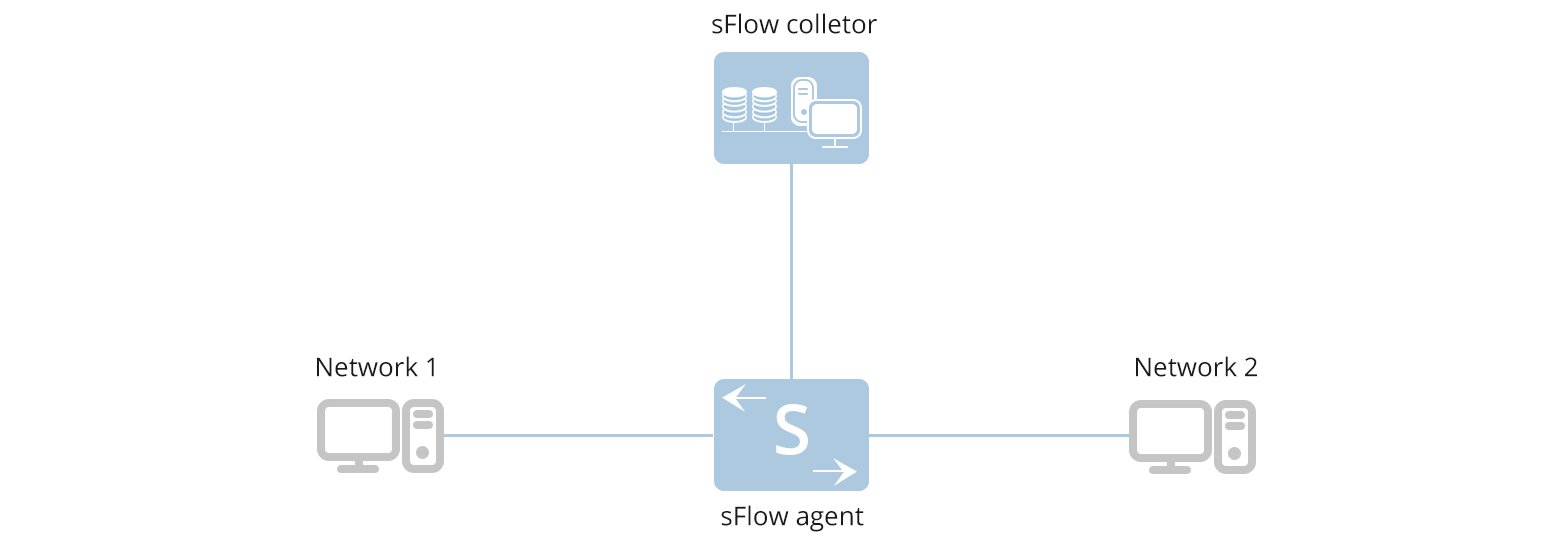Things You Should Know About sFlow
What Is sFlow?
sFlow (Sampled Flow) is a traffic monitoring technology that collects traffic statistics by sampling packets and analyzing them. It analyzes traffic on a per-interface basis to monitor traffic in real-time, detect abnormal traffic, and locate the source of attack traffic promptly, greatly facilitating routine inspection and maintenance for enterprises.
Application Scenarios of sFlow
Enterprises often have specific demands regarding traffic management on device interfaces and the overall operational status of their devices. They seek a traffic monitoring solution that samples packets on device interfaces to swiftly detect abnormal traffic and pinpoint the sources of potential attack traffic. This capability allows for prompt fault rectification, ensuring the smooth operation of their networks. With its focus on interface traffic, traffic forwarding, and device status, sFlow is well-suited for monitoring and identifying network anomalies, particularly within enterprise environments. In a typical sFlow networking setup, as illustrated below, a sFlow agent is connected to a remote sFlow collector, enabling the collection and analysis of traffic statistics based on interfaces.

How Does sFlow Work?
sFlow System Architecture
The architecture of a sFlow system comprises a sFlow agent integrated into a Huawei device and a remote sFlow collector. The agent gathers traffic statistics from an interface through packet sampling and packages them into sFlow packets. Once the sFlow packet cache reaches capacity or when sFlow packets reach their aging threshold (1-second aging period), the agent transmits the sFlow packets to the sFlow collector. Subsequently, the collector processes and presents the analysis results derived from the sFlow packets.

sFlow Packet Structure
sFlow packets are encapsulated using the UDP protocol. By default, sFlow packets are directed to the well-known port 6343. These packets adhere to specific header formats, including Flow sample, Expanded Flow sample, Counter sample, and Expanded Counter sample. The expanded Flow sample and Expanded Counter sample are introduced in sFlow version 5 as enhancements to the Flow sample and Counter sample, respectively. It's important to note that these extensions are not backward-compatible with earlier versions. Any extended sampling data must be enclosed within the headers of Expanded Flow sample or Expanded Counter sample format.
sFlow Sampling Methods
sFlow agents offer two sampling methods: flow sampling and counter sampling.
Flow Sampling
In flow sampling, the sFlow agent selects packets in the designated direction on a particular interface according to a predefined sampling rate. It then analyzes these packets to extract information about their content. Flow sampling is centered around capturing detailed traffic information, enabling comprehensive monitoring and analysis of network traffic behaviors.
Table 1-1 Main fields in flow sampling packets

Counter Sampling
Counter sampling involves the periodic collection of traffic statistics on a specific interface by a sFlow agent. The primary focus of counter sampling is to gather and report traffic statistics rather than delve into the intricacies of traffic content. The table below outlines the key fields found in counter sampling packets. Unlike flow sampling, counter sampling prioritizes the aggregation of traffic statistics on an interface rather than detailed traffic analysis.
Table 1-2 Main fields in counter sampling packets

The Role of sFlow in Switches
sFlow plays a crucial role in switches, offering the following functionalities:
-
1. Real-time Traffic Monitoring: By sampling packets, sFlow allows administrators to monitor traffic on switches in real-time. This real-time monitoring helps in quickly identifying abnormal traffic, bottlenecks, and other performance issues.
-
2. Network Troubleshooting: sFlow captures and records traffic information on switches, aiding administrators in tracking and diagnosing network faults. By analyzing traffic data, administrators can promptly determine the root causes of network issues and take appropriate measures for resolution.
-
3. Security Monitoring: sFlow can be used to detect and locate network attacks. By monitoring traffic patterns and identifying anomalous traffic, sFlow helps administrators to timely detect and respond to potential security threats, including DDoS attacks, malicious traffic, etc.
-
4. Performance Optimization: sFlow provides key performance indicators of switches, such as bandwidth utilization, traffic distribution, etc. This information assists administrators in optimizing network configurations to improve network performance and efficiency.
How FS Can Help
In conclusion, sFlow emerges as a vital technology in modern network infrastructure, offering enterprises real-time traffic monitoring, effective troubleshooting, robust security monitoring, and performance optimization capabilities. Its role in switches is particularly noteworthy, facilitating seamless network management and ensuring the smooth operation of critical infrastructure. As organizations prioritize network reliability and security, sFlow remains an indispensable tool in their toolkit.
Furthermore, as a leader in the communication industry, FS stands at the forefront of innovation and excellence. FS integrates sFlow functionality into its data center switches, demonstrating its commitment to providing cutting-edge solutions tailored to meet the evolving needs of businesses in today's dynamic digital landscape. With FS's sFlow-enabled switches, enterprises can confidently navigate network complexities, enhancing operational efficiency and fortifying their security posture.
You might be interested in
Email Address

-
PoE vs PoE+ vs PoE++ Switch: How to Choose?
Mar 16, 2023















